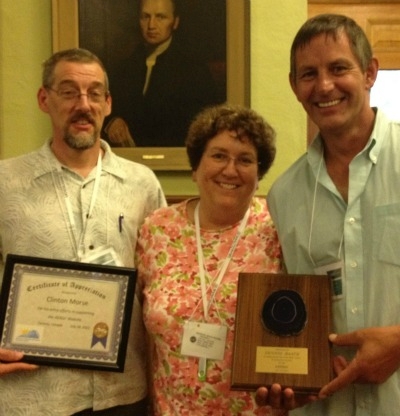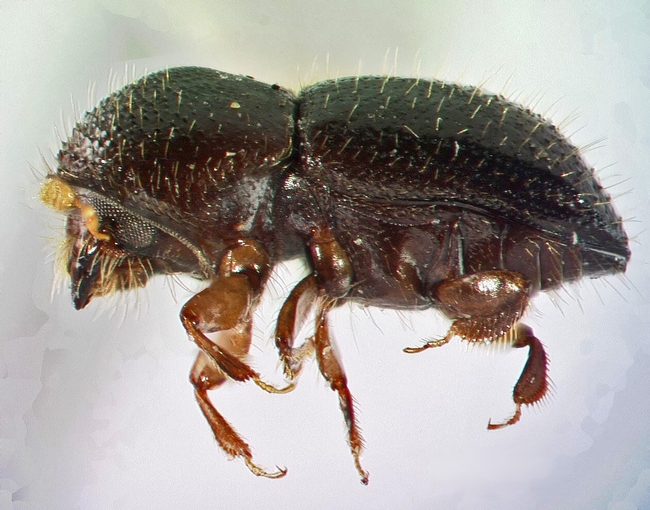UC Blogs
UC facility coordinator presents awards at Toronto conference
Laura Van der Staay, program and facility coordinator at the UC Kearney Agricultural Research and Extension Center, presented awards of appreciation at the annual conference of the Association of Education and Research Greenhouse Curators, reported Greenhouse Canada. Van der Staay is chair of AERGC.
Clinton Morse of the University of Connecticut received a certificate of appreciation for his efforts in supporting the AERGC with information and communications technology. Dennis Raath of Lock Drives received a certificate of appreciation plaque in recognition of his years of dedicated service to the association.
About 120 delegates from across North America – and one from Germany – attended the three-day conference held at the University of Toronto.
Licorice Plant-Yum!
Well not really, I don't know why this very hardy shrubby perennial is commonly called a "licoriceplant". Well maybe my sense of smell is off these days. Helichrysum petiolatum first attracted me because of its light grey color and soft looking overall appearance. As for aroma, if anything, it smells like curry more than anything else. What a workhorse, this woody shrub far exceeds the size quoted in my reference guide achieving a size of 8 by 8 feet and about 4 feet tall. I have to keep giving it a trim as it wants to grow out into the sidewalk. I had a second one but finally had to remove as it continues to intrude on its neighbors. So be forewarned, this very happy perennial likes to spread out and will quickly fill up a space. The flowers are said to be "inconsequential" but I find them charming. They add to the overall soft appearance which I find pretty rare in most tough drought tolerant shrubs. Go for this plant if you have room, brush by and you might need to find an Indian curry soon.
Please note that the licoriceplant is an invasive plant to natives. For more information, visit this site to learn more http://www.cal-ipc.org/ip/management/plant_profiles/Helichrysum_petiolare.php.
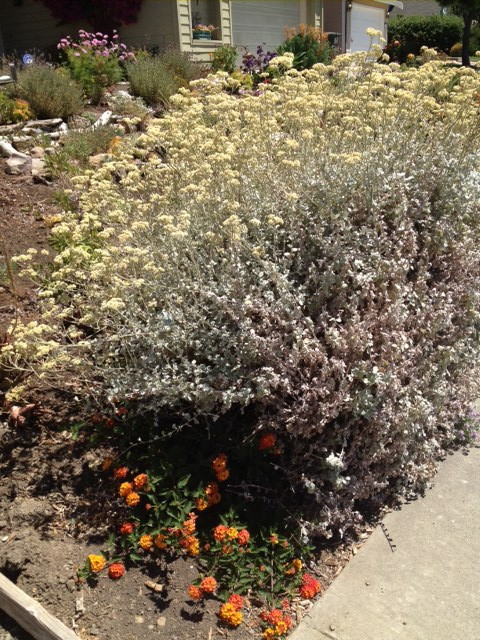
Licoriceplant. (photo by Trisha Rose)
Beetle threat to California's oak and avocado trees
The Polyphagous shot hole borer is a beetle that attacks oak and avocado trees, causing branch dieback and eventually death. The beetle bores into the trees and spreads a fungus that, in turn, attacks the vascular tissue of the tree and disrupts water and nutrient flow. The beetle also attacks coast live oak, box elders and other trees.
Both the fungus and the beetle were discovered on several backyard avocado trees in residential neighborhoods and a commercial avocado grove in Los Angeles County earlier this year.
Scientists from the University of California, Riverside, and others are meeting on Aug. 12-14 in Riverside to discuss the beetle, its biology, the fungus it spreads, and strategies to effectively monitor and control the pest.
The public is invited to attend the free open session of the three-day meeting from 2 p.m. to 5 p.m. on Tuesday, Aug. 14, at the Marriott Riverside Hotel, 3400 Market St., Riverside, Calif.
At the public meeting, the scientists will address the new beetle/fungus complex and explain what problem it poses, the extent of the problem in California, what detection and control measures are currently available, and how Israel is dealing with the same pest. A Q&A session is scheduled for 4:25 p.m.
For more information, including how to register for the public meeting, visit: http://ucrtoday.ucr.edu/8129
No Sweat Being Green
Beekeepers describe their honey bees as "my girls" or "my beautiful girls." It's a term of endearment. Now take the green metallic sweat bee,...
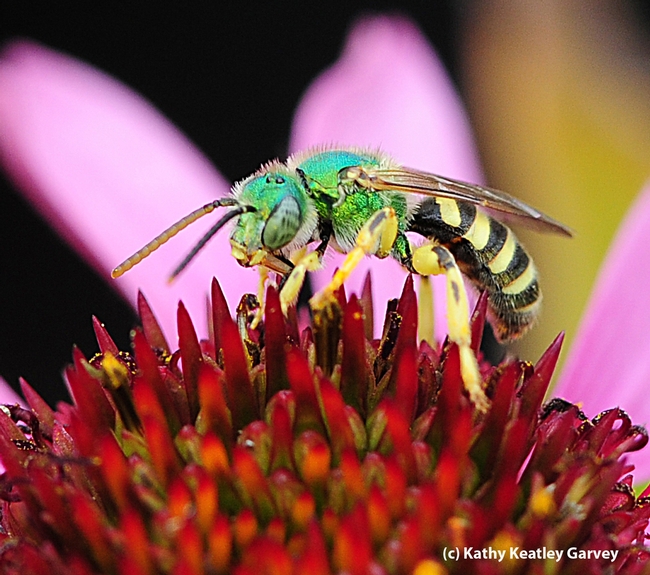
Male sweat bee, Agapostemon texanus, on purple coneflower. (Photo by Kathy Keatley Garvey)
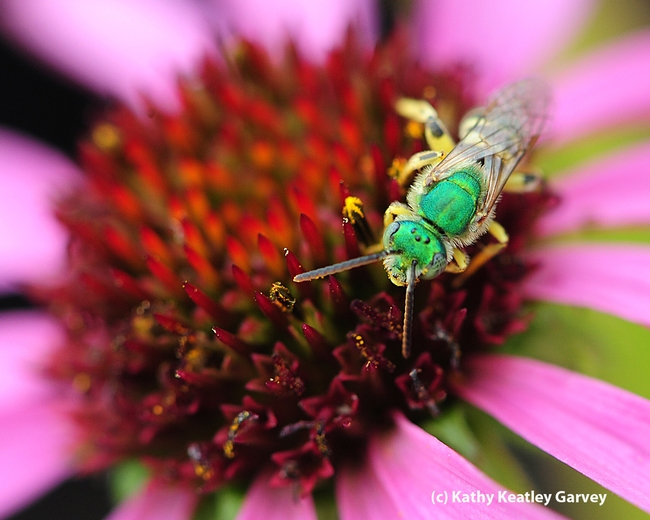
Note the metallic green head and thorax of a male sweat bee, Agapostemon texanus. (Photo by Kathy Keatley Garvey)
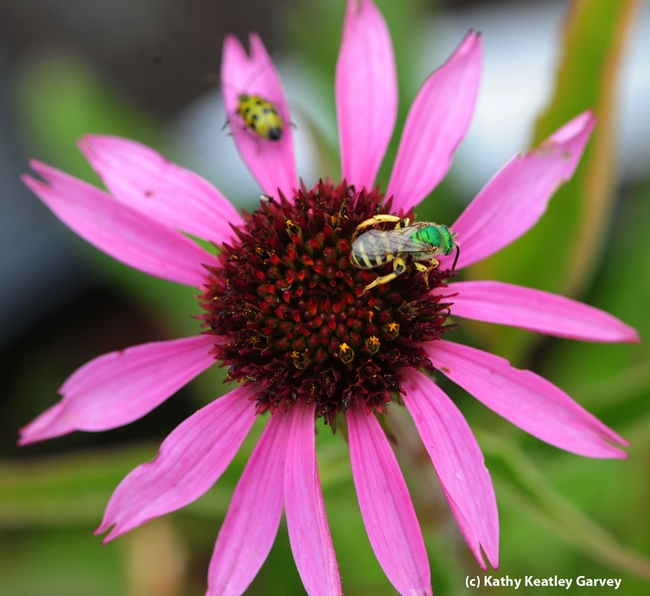
Spotted cucumber beetle (a pest) and male sweat bee, Agapostemon texanus, sharing a purple coneflower. (Photo by Kathy Keatley Garvey)
Plants: What Do They Know?
Do plants see, smell, feel, hear, remember and know where they are?
These are some of the questions that Daniel Chamovitz who has a PhD in genetics writes about in his book “What a Plant Knows”. One of the discoveries scientists found in their research, was that plants and animals have some of the same genes as humans DNA.
Do they see? Plants do not have eyes like animals or humans, but according to some researchers they see when it’s light and when it’s dark, they seem to sense which side the light is coming from. Could that explain why they grow towards the light? What about plants that grow in the shade, do they wilt and die because of the light? My question is how does this explain night-blooming plants, where there is only a street light or the moon for light? How do they know it’s time to bloom or when night comes? Is this the sense scientists are talking about?
Do plants smell odor? We know that they are a lot of plants that have odor, roses, sweet peas, society garlic to name just a few, but some scientist studies show they can smell odors from plants near them as well as their own aroma. These scientists also think they can sense when their or their neighbor’s fruit is ripe.
Do they feel? Some say yes they suggest they can tell the difference between hot and cold, when something brushes them, the wind, animals or humans. Researchers also think plants are more sensitive to touch then we humans are. The slightest touch will cause some to close their leaves.
Can they hear? On this question there is little credible research that they hear, or if they do how they respond to sound. Yet we have all heard that talking to plants helps their growth. Is this a myth? Even biologists Charles Darwin, played his own bassoon to see if his mimosa plant (Mimosa pudica) would close- when it didn’t he called it a “fools experiment”.
Do they remember? Some of the plants memory faculties are the same as humans, but they don’t have memories like we do, they don’t remember sunshine or drought, but in their own way they do retain some past events such as any damage done to them by insects or humans.
Do they know where they are? Again scientists differs on this; some say yes, other are not sure. They say plants know roots grow down, shoot up, just like tendrils usually know where support is for them to attach to. So if a seed is planted how it does know roots grow down, shoot up if they are not aware where they are.
This is a very interesting book that I only touch the surface on, but for plant lovers it has a lot of information from the author and researchers on if plants see, smell, feel, hear, and remember.
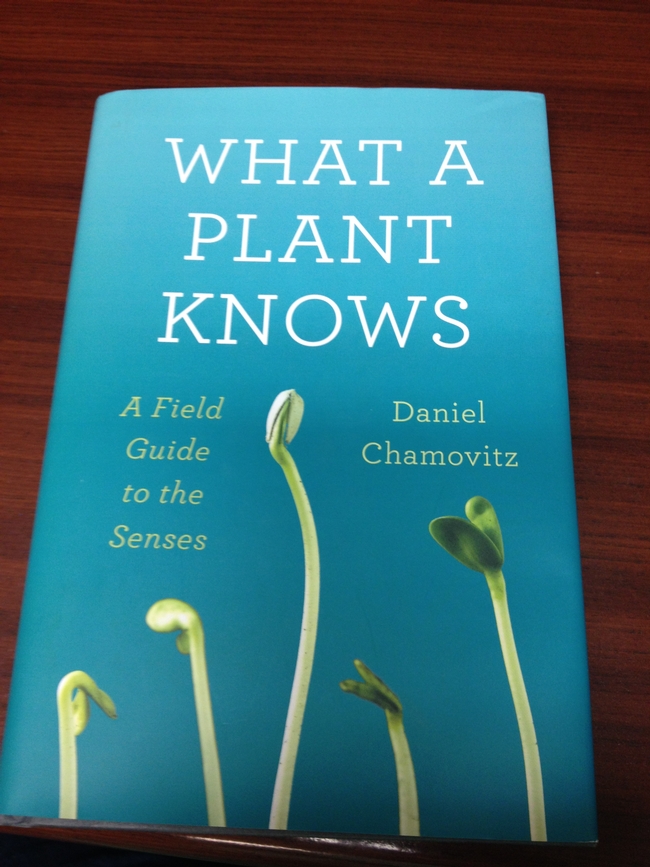
book cover what a plant knows


